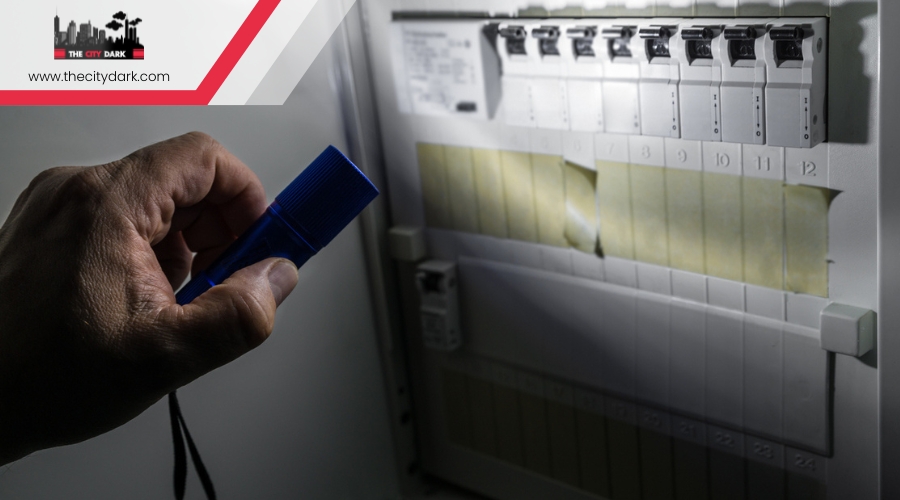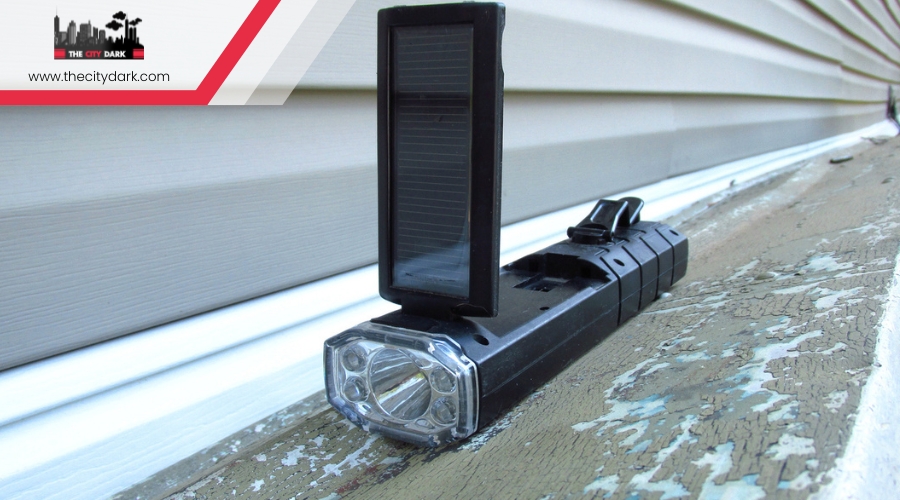How Do You Survive a Catastrophic Power Outage?
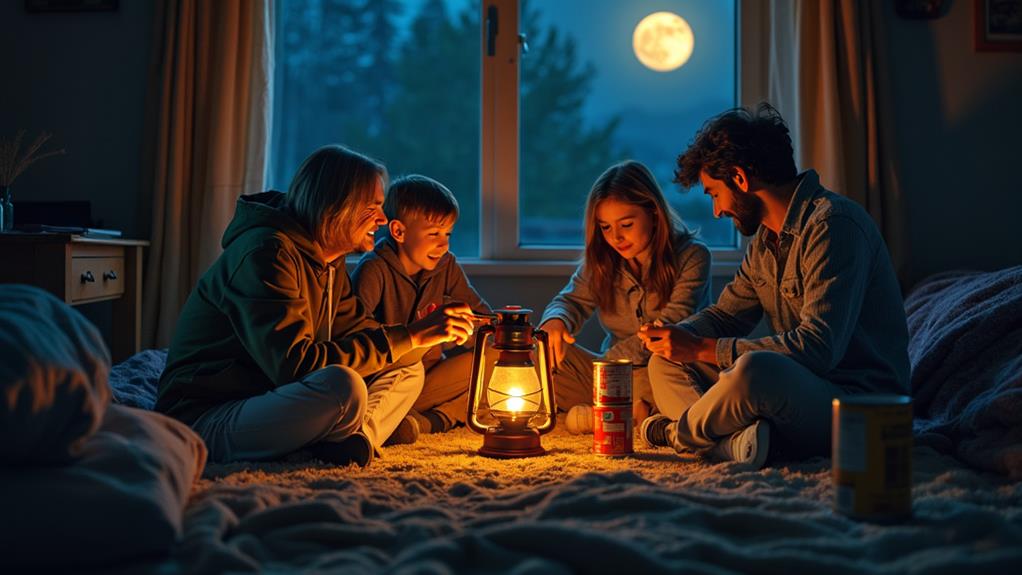
In the event of a catastrophic power outage, your immediate actions are crucial. First, ensure you have a well-stocked emergency kit with essentials like non-perishable food and water. Communication with neighbors is vital, as sharing resources and updates can enhance everyone's safety. Use gas for cooking if available and follow safety protocols when using a generator. Keeping your home insulated can help maintain a comfortable temperature. Additionally, consider less obvious strategies such as using solar chargers for electronic devices and having a manual can opener. These steps can save you both time and stress.
Write Important Information on Paper

When a catastrophic power outage occurs, writing essential information on paper can be a lifesaver. Do not rely solely on electronic devices that may fail when you need them most. Maintain a written list of critical phone numbers and addresses, including local hospitals and shelters, to ensure you can quickly access help during power outages.
It is also crucial to document significant contacts and information, such as medical needs and emergency plans. Create an emergency contact card for each family member, listing their vital information, and ensure everyone has a copy. This preparation ensures that, in case of an evacuation, each person knows what to do and who to contact.
To conserve phone battery life, use power-saving settings and switch to airplane mode when not in use. Additionally, have a backup charging solution ready. Identify nearby libraries or community centers that may offer power access during an outage, and write down their addresses for easy reference.
Use Gas to Cook Food
Having vital information on paper is essential, but ensuring you can cook and eat during a power outage is equally important. You can use gas to cook food, but remember that gas stoves might not light automatically without power. Keep matches or a lighter handy for ignition. If you're using a gas grill, check for damage and leaks by performing a bubble test to ensure it's safe. Cook perishable foods within four hours of losing power to prevent spoilage. A full freezer can keep food cold for up to 48 hours, extending the window before you need to cook.
Safety is paramount when using gas to cook food. Always ensure proper ventilation and never use gas stoves or grills indoors to avoid the risk of carbon monoxide poisoning. Cooking outdoors with a gas grill is a good option, but make sure it's in a well-ventilated area. Additionally, avoid using any food that has come into contact with floodwaters, as it poses serious health risks. By following these steps, you can safely prepare meals and maintain your health during a power outage.
Use Your Generator Safely
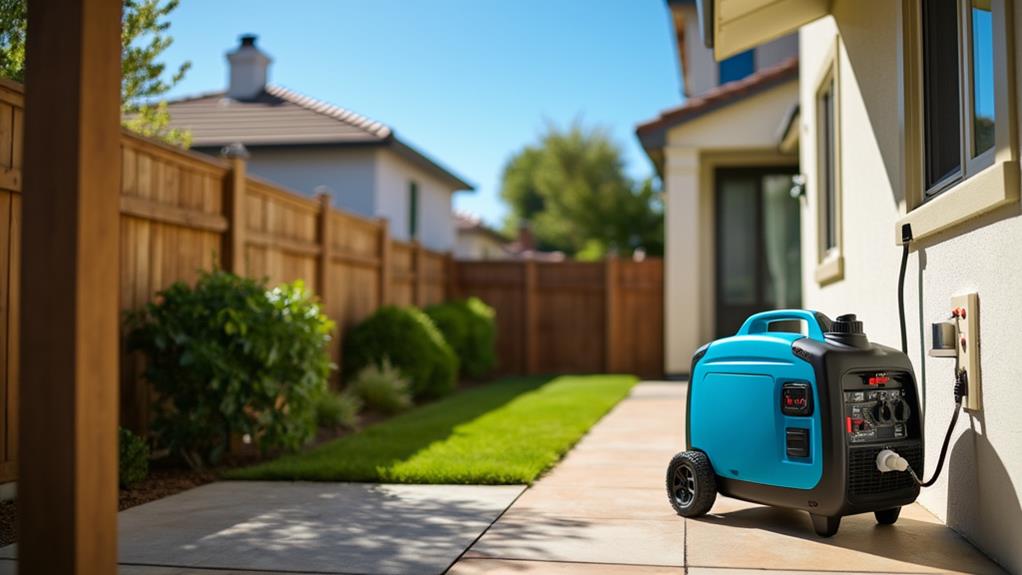
Using your generator safely is essential to avoid accidents and ensure continuous power during an outage. Never operate your generator indoors or in enclosed spaces such as garages, as this can lead to carbon monoxide poisoning, which is responsible for about 85 deaths annually in the U.S. To mitigate this risk, always place your generator at least 20 feet away from your home and direct the exhaust away from windows and doors to minimize exposure to harmful fumes.
When connecting appliances to your generator, use outdoor-rated extension cords and adhere to the manufacturer's guidelines for safe operation. This ensures your equipment functions properly and reduces the risk of electrical hazards. Additionally, conduct a bubble test to check for gas leaks before using gas-powered equipment. This involves applying a soapy water solution to the connections and looking for bubbles, which indicate a leak.
Unplug Your Appliances
Unplugging your appliances during a power outage can prevent damage from power surges when electricity is restored. Keep an eye on nearby streetlights or neighboring houses to know when it's safe to plug your devices back in. This simple step can protect your sensitive electronics and help you avoid costly repairs or replacements.
Prevent Electrical Damage
Protecting your household electronics and appliances during a power outage is essential to avoid costly damage. When the power goes out, unplug your devices to shield them from potential power surges that can occur when electricity is restored. Power surges are sudden spikes in voltage that can damage sensitive electronics, leading to expensive repairs or replacements.
There is no specific order needed when unplugging; simply disconnect all major appliances and electronics, including TVs, computers, and kitchen gadgets. For a quicker method, you can shut off the main circuit breaker, cutting off power to your entire home and preventing surge damage.
As utility companies work to restore electricity, fluctuations in power can occur, putting plugged-in devices at risk. To minimize this danger, monitor nearby street lights or neighboring houses to gauge when power is back on. Wait a bit longer to confirm the system has stabilized before plugging your appliances back in.
Monitor Power Restoration
As you wait for power to be restored, it's crucial to monitor the situation to protect your appliances from potential damage. Unplugging appliances is essential to avoid damage from power surges that can occur when electricity returns. You don't need to follow a specific order; simply unplug everything to ensure safety. Alternatively, you can turn off the main circuit breaker to prevent surge damage.
Stay informed by monitoring local updates through news, radio, or social media. Keeping an eye on nearby street lights or houses can also help you gauge when power restoration is imminent. Communicating with neighbors can provide additional insights and context for safely re-energizing your home.
Here's a quick guide to help you stay on top of things:
| Task | Action |
|---|---|
| Unplugging Appliances | Disconnect all electrical devices |
| Monitoring Updates | Check news, radio, or social media |
| Watching Street Lights | Observe for signs of power return |
Safeguard Sensitive Electronics
To safeguard your sensitive electronics during a power outage, unplugging your appliances is essential. Power surges can occur when utility services are restored, potentially damaging valuable devices. By unplugging appliances, you can prevent these surges from causing costly repairs. While unplugging, there's no need to follow a specific order, but consider shutting off your main circuit breaker for added protection to your home's electrical system.
Monitor nearby street lights or neighbors' houses as indicators that power has been restored. Once you see the lights come back on, you can safely reconnect your appliances. If you cannot unplug all of your devices, using surge protectors can help mitigate the risk of damage from electrical spikes when power returns.
Check on Neighbors
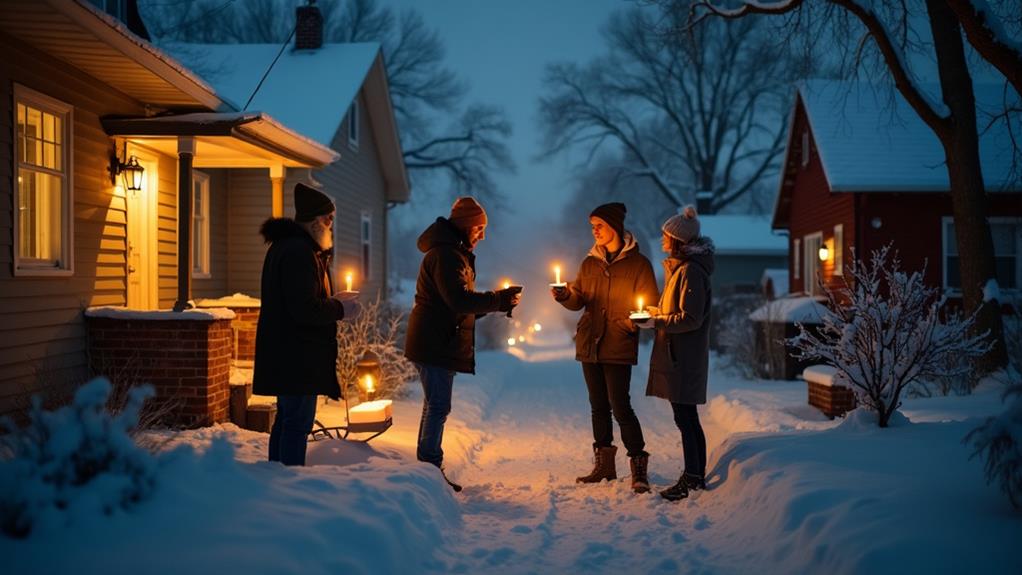
During a power outage, it's crucial to check on your neighbors, particularly the elderly or disabled, to ensure their safety and well-being. Offer necessary assistance and set up a system to share updates on power restoration and resource availability. If the outage persists, coordinate relocation plans and communicate clearly with everyone involved to build a supportive community.
Safety and Well-being
Building strong communication with your neighbors during a power outage can be crucial for everyone's safety and well-being. Establishing a check-in system ensures timely updates on power restoration and facilitates the efficient sharing of resources, which is especially important for the elderly or disabled who may need extra assistance.
Begin by creating a contact list of your neighbors, noting any special needs or medical conditions. This list will streamline communication during a power outage, helping you quickly identify who might need immediate help. Encourage everyone to stay informed about local news and emergency services, as this can guide better decision-making regarding safety and potential evacuation.
Regular check-ins foster a sense of community and collective resilience. Sharing food, water, or charging devices can be essential for those less prepared. Don't hesitate to knock on doors or send messages to ensure everyone is okay. In an extended outage, such vigilance could prevent accidents and even save lives.
Offer Essential Assistance
After establishing strong communication with your neighbors, the next step is to offer essential assistance by regularly checking on them. In an emergency, it's crucial to ensure everyone's safety, particularly those who may be vulnerable, such as the elderly or those with mobility issues. Regularly visit or call your neighbors to confirm their well-being and see if they need any supplies or support.
Developing a reliable communication system is key to surviving a power outage. This system can help you share updates on power restoration and available resources, keeping everyone informed and connected. Make sure to include methods for reaching those who might not have access to digital devices.
If the power outage persists, consider finding alternate locations with power for yourself and your neighbors. Coordinate travel plans with safety as the priority, and inform everyone involved about your relocation plans. This fosters a supportive network and ensures no one is left in the dark, both literally and figuratively.
Communication and Updates
Ensuring consistent communication during a power outage is essential for safety and well-being. Begin by regularly checking on neighbors, especially the elderly or disabled, to confirm their safety and offer assistance. Effective communication can be as simple as a quick knock on the door or a group text, assuming cellular service is available.
Establish a system to share updates about the power grid's status. This could involve setting up a group text or using a community bulletin board to keep everyone informed about power restoration timelines and important safety information.
Develop a neighborhood plan that includes shared access to charged devices or communal gatherings for information sharing, which can be particularly useful during prolonged outages. If someone has a generator, consider pooling resources for the community's benefit.
Be aware of alternate locations like community centers or libraries that may still have power. Inform neighbors about these resources to ensure everyone has access to necessary facilities.
Ensure Food Safety
When a power outage occurs, your top priority should be ensuring the safety of your food to prevent foodborne illnesses. Immediately focus on food safety by keeping refrigerator and freezer doors closed as much as possible. A full freezer can keep food safe for up to 48 hours, while a half-full freezer maintains safe temperatures for about 24 hours.
If the outage seems prolonged, check your water supply to ensure you have enough for food preparation and drinking. Discard any perishable items that have been above 40°F for more than two hours to prevent foodborne illnesses. Cook perishables within four hours of power loss using alternatives like gas stoves, outdoor grills, or camp stoves. Always follow safe cooking practices to avoid contamination.
For extended outages, rely on canned foods that can be eaten directly from the can without cooking, as they do not require refrigeration. Finally, discard any food items that have come into contact with floodwaters, as such contamination poses significant health risks. By following these guidelines, you can ensure your food remains safe during a power outage.
Stay Warm or Cool

When the power goes out, insulate and seal your home to maintain a stable indoor temperature. Use alternative heating methods like outdoor-rated propane heaters, ensuring they are safely positioned. If staying home isn't feasible, seek shelters with reliable heating or cooling, and always check on vulnerable neighbors.
Insulate and Seal Home
Preparing your home for a catastrophic power outage involves more than just stockpiling supplies; it's about creating a barrier against the elements. Start by insulating exposed pipes to prevent them from freezing in cold weather. This simple step can help maintain a more consistent indoor temperature.
Next, seal drafts around windows and doors using weatherstripping or caulk to close gaps, dramatically improving your home's energy efficiency. This action keeps your space warmer in winter and cooler in summer, reducing the strain on backup heating or cooling methods.
Thermal curtains are another effective way to insulate your home. During winter, close them at night to retain heat, and in summer, keep them drawn during the day to block out heat. If thermal curtains aren't available, covering windows with blankets can provide additional insulation.
Don't overlook your attic and basement. Incorporating foam board or reflective insulation in these areas reduces temperature fluctuations, making your living spaces more comfortable. Regularly check and maintain insulation in attics and walls, ensuring proper ventilation to enhance your home's energy conservation during outages.
Utilize Alternative Heating Methods
After insulating and sealing your home to create a barrier against the elements, it's essential to think about staying warm or cool during a catastrophic power outage. In winter, using alternative heating methods like propane heaters, kerosene heaters, or wood stoves can help maintain warmth. However, ensure proper ventilation to avoid carbon monoxide buildup, which can be deadly. Your insulated home will retain heat more effectively, so close curtains or blinds to optimize this benefit.
For extreme heat, staying cool is critical. Occupy the coolest area of your home, wear light clothing, and use battery-powered fans or wet cloths to help regulate your body temperature. Keeping emergency blankets or sleeping bags handy can provide supplementary insulation and warmth when temperatures drop considerably, ensuring you stay comfortable.
Seek Shelter Options
During a catastrophic power outage, finding appropriate shelter is crucial. In winter, choose the warmest room in your home, ideally one with minimal windows and good insulation to retain heat. Layer your clothing and use blankets to maintain body warmth. If temperatures drop significantly, consider using a fireplace or an outdoor grill for warmth, ensuring proper ventilation to prevent carbon monoxide buildup.
In extreme heat, staying cool is essential. Use battery-powered fans if available and wear light, breathable fabrics to manage body temperature. If your home becomes intolerable, seek out community centers or designated shelters with power and climate control. These places often provide essential refuge during emergencies.
Community centers are invaluable during power outages, offering a controlled environment and the opportunity to connect with others facing similar challenges. Knowing the locations of these shelters in advance can be significantly beneficial.
Always prioritize safety by selecting the best available shelter, whether it's within your home or at a community center. Stay vigilant and prepared to protect yourself from the elements.
Follow Safety Precautions
When facing a catastrophic power outage, prioritizing safety precautions is crucial. Ensure that any generators you use are operated outdoors and at least 20 feet away from your home to prevent carbon monoxide (CO) poisoning, which tragically claims around 85 lives annually. Always ensure proper ventilation when using outdoor cooking equipment. Never use grills or camp stoves indoors, as they can lead to hazardous CO buildup.
Regularly check and maintain smoke detectors and carbon monoxide detectors. Fresh batteries are essential for these devices to function efficiently, providing you with necessary warnings in case of CO presence or fire.
Keep fire extinguishers accessible and check them regularly. They can be vital in preventing small fires from escalating, especially during a power outage when emergency services might be delayed.
Prepare for Seasonal Outages

Seasonal power outages require specific preparation strategies to ensure your household remains safe and functional. During summer, high air conditioning use can strain power systems, while winter's cold can damage infrastructure. It's crucial to understand the risks each season presents.
In hurricane-prone southern states, prepare for both wind and flooding impacts. Secure your home against high winds and elevate significant items to prevent flood damage. Store a three-day supply of water per person (one gallon per day) to ensure hydration if water services are disrupted.
Wildfire season demands a different approach. Power may be shut off to prevent fires, so have a backup plan. Know your local alert systems and have an evacuation plan ready.
Winter brings challenges like ice and high winds, increasing the risk of downed power lines. Insulate your pipes to prevent freezing and have alternative heating solutions like a wood stove or propane heater available.
Stock Up on Essentials
Building a robust emergency supply kit is essential for surviving a catastrophic power outage. Start by stocking up on non-perishable foods, such as canned goods and dried staples, to sustain each person in your household for at least three days. Items like beans, rice, and canned vegetables are ideal as they provide essential nutrients and have a long shelf life.
Water is crucial during any emergency. Keep at least one gallon of water per person per day, accounting for pets as well. This will cover drinking, cooking, and basic sanitation needs.
Organize your emergency supplies in clearly labeled bins that are easily accessible for quick retrieval. Regularly check and update your kit, replacing expired items and ensuring all necessary medications are included.
Consider investing in a generator or alternative power solutions to provide backup energy for essential appliances and devices during prolonged outages. This ensures you can stay connected and keep your food supply safe.


